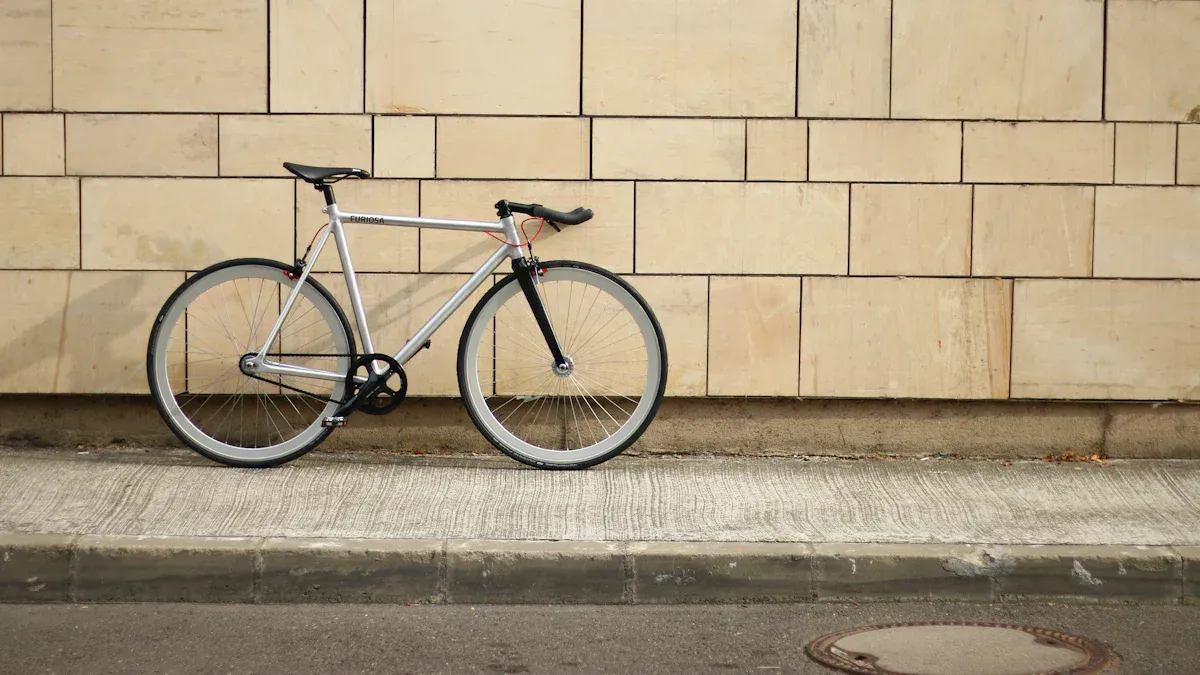
When picking a touring bike, you often think about the frame materials: aluminum or steel. Each material has its own pros and cons. Many cyclists pick aluminum because it is cheaper and lighter. On the other hand, lots of people like steel frame touring bikes for their comfort and strength. Surveys show that about 58% of cyclists appreciate the smooth ride that steel gives. But there are some common myths. People often think aluminum is comfortable, but its stiffness can cause more bumps on long rides. Knowing these things can help you make a smart choice for your next trip.
Key Takeaways
Steel touring bikes give a smooth and comfy ride. They absorb bumps well, which is good for long trips.
Aluminum bikes are lighter and faster. However, they can feel stiff and less comfy on bumpy roads.
Steel frames last longer and are easier to fix on long tours. This adds reliability to your adventure.
Weight is important: aluminum frames are lighter. But steel frames offer better stability when carrying heavy loads.
Choose your bike based on how you ride. Pick steel for comfort and durability, or aluminum for speed and lightness.
Performance

Ride Quality
When you think about ride quality, aluminum and steel bikes are different. Steel frames usually give a softer and more comfortable ride. Many cyclists say it feels classic and smooth. This comfort comes from steel’s natural bendiness. It can soak up bumps in the road better than aluminum. On the other hand, aluminum frames are stiffer. This stiffness can make the ride feel more lively, but it might also make long trips feel rougher.
Test results back this up. Riders on aluminum bikes have seen speed boosts of about 5 km/h compared to steel bikes. Climbing speeds got better by around 10% to 20% when moving from a steel mountain bike to an aluminum road bike. But this speed gain can mean less comfort. If you want a smooth ride more than speed, you might choose steel frame touring bikes.
Handling
Handling also changes a lot between the two materials. Steel frames, especially those made from CroMo, are often liked for touring. They balance strength, flexibility, and comfort well. This flexibility helps with stable and comfy handling, especially when your bike is loaded. Steel frames handle bumps and shakes better, making them great for rough paths.
In contrast, aluminum frames can feel less steady when heavy. They are lighter and stiffer, but this stiffness can make the ride less predictable, especially on steep descents. Touring bikes need a frame that can handle long, fast descents safely. Steel’s mix of stiffness and flexibility meets this need well. The longer wheelbase and steady steering shape of touring bikes improve handling, making steel frames a good choice for different loads.
Weight of Frames

When you pick between aluminum and steel touring bikes, weight is very important. You want a bike that feels good for how you ride and how far you go.
Aluminum Frame Weight
Aluminum frames are usually lighter than steel ones. This lightness comes from aluminum being less dense, about 2.8 g/cm³. To make aluminum strong and stiff, it often uses thicker tubes with bigger diameters. This design helps keep strength while being light. For example, an aluminum frame can weigh about one-third less than a steel frame of the same size. But the difference isn’t as big as it looks because aluminum needs to be made stronger to match steel’s strength.
Here’s a comparison of weight increases for different frame parts:
Frame Part | Aluminum Tubing (OD mm / Wall mm) | Weight Increase per Size (g) | Steel Tubing (OD mm / Wall mm) | Weight Increase per Size (g) |
|---|---|---|---|---|
Head Tube (HT) | 50.0 / 3.5 | 24 | 47.0 / 1.6 | 30 |
Seat Tube (ST) | 35.0 / 1.5 | 9 | 28.4 / 1.0 | 13 |
Down Tube (DT) | 42.0 / 1.5 | 6 | 34.9 / 0.8 | 7 |
Top Tube (TT) | 35.0 / 1.4 | 4 | 31.8 / 0.8 | 5 |
Seat Stays (SS) | 19.0 / 1.2 | 5 | 12.0 / 0.7 | 6 |
Total per size increase | 48g (~52g with paint) | 61g (~65g with paint) |
Steel Frame Weight
Steel frames are heavier and denser, weighing around 7.8 g/cm³. This means steel frames feel stronger and more stable, especially when carrying gear. A typical touring bike weighs between 30-33 lbs. This extra weight helps with stability and durability. Heavier bikes often handle loads better, making them great for long trips.
You might see that the extra weight of a steel frame can make rides more comfortable and stable on bumpy roads. While lighter bikes feel quicker, the added weight of steel frames can improve your overall ride. For most touring situations, the benefits of being strong and comfortable are worth the few extra pounds.
Durability
When you think about how long touring bikes last, you need to compare steel and aluminum. Each material has special traits that affect how long your bike will work and how well it can take damage.
Steel vs Aluminum Durability
Steel frame touring bikes usually last longer than aluminum ones. Aluminum frames can last about 5 to 10 years or around 200,000 km with normal use. But they often fail because of fatigue cracks. Things like frame design, how they are made, and the environment can change this lifespan. On the other hand, steel frames wear out much slower. Some reports say steel touring frames can last 20 years or more. This long life makes steel frames a favorite for long trips.
Tests show that well-made aluminum frames can be very strong and last long. For example, the Cannondale CAAD3 aluminum frame lasted 200,000 cycles without breaking. In comparison, some steel frames like the Barellia SLX lasted about 119,000 cycles. While aluminum frames can do well in lasting long, steel frames handle small damage better and resist some types of rust more. So, when you think about durability and how easy they are to fix, steel frames usually win.
Repairability
Fixing a broken frame can be very important on long trips. Steel bike frames are easier to repair in faraway places. If you have a problem, you can often fix a steel frame with simple tools and welding gear. Even though repairs can be tough because steel tubing is thin, skilled workers can do it well.
Aluminum frames can also be fixed, even without special heating, and they can stay strong for years after being repaired. But welding aluminum needs special skills to avoid weak spots. Both frame types can be repaired, but fixing steel might be easier.
For maintenance, you should check both frame types regularly. For steel frames, washing them often helps get rid of sweat and salt that can cause rust. Putting rust blockers inside frame tubes can stop rust from forming inside. For aluminum frames, managing salt is important, but rust is less of a worry. Keeping the paint safe from chips and cable rub is key to keeping the frame strong.
Comfort
Vibration Absorption
When you ride a touring bike, comfort is very important, especially on long trips. Steel frames are great at absorbing vibrations. Their strength and flexibility help them soak up bumps from rough roads. This makes your ride smoother and more fun. On the other hand, aluminum frames are stiffer. This stiffness can make the ride feel rougher, which can make long distances less enjoyable.
Here are some important points about how steel frames absorb vibrations:
Steel frames give a smooth ride because they are naturally springy.
The special shape of steel frames helps with stability and responsiveness, making long rides more comfortable.
Many popular touring bikes, like the Dawes Ultra Galaxy and Surly Disc Trucker, are known for their comfy design and ability to absorb shocks.
Rider Fatigue
Rider fatigue can spoil your touring adventure. Steel frame touring bikes help lessen this tiredness. Their design lets you sit in a more relaxed position, which is important for long rides. Comfortable saddles, like the Brooks B17, along with ergonomic handlebars, make your ride even better.
Also, wide tires on steel touring bikes soak up shocks well. This feature adds stability, making long rides feel smoother. You can ride longer without getting as tired.
Aesthetics
Design Options
When you think about how touring bikes look, aluminum and steel have different styles. Aluminum frames usually have modern designs that many cyclists like. Here are some popular design features of aluminum touring bike frames:
Popular Models: Bikes like Cannondale’s CAAD3 and Nashbar’s aluminum frames are loved for their smooth looks.
Tire Considerations: The width and pressure of tires are important for comfort and reducing bumps on aluminum frames.
Material Choices: Special aluminum alloys, like 7005, are used in bikes like the Koga Miyata WTR, showing careful material choices.
Geometry and Clearance: The shape of the frame and tire space are key for comfort. For example, the CAAD3 has limits on tire size that affect how good it is for touring.
Customization: Some riders like custom aluminum frames with longer wheelbases for better stability on tours.
Timeless Elegance
Steel frames have a classic elegance that many cyclists love. Their traditional design features give them a stylish look. Here are some things that make steel touring bikes look elegant:
Quality Materials: High-quality chromoly steel tubing, like triple butted 4130 Chromoly, is a sign of classic steel frames.
Finishing Details: Clean frame lines without extra parts create a neat and simple look.
Functional Design: Many mounting points for racks and water bottles keep them practical while looking good.
Smooth Cable Routing: Good construction methods improve the overall sleek look.
Timeless Color Options: Steel frames often come in colors that are not too trendy, which adds to their classic charm.
Both aluminum and steel frames have their own style strengths. You can pick based on your personal taste and what you need for your touring trips.
Choosing between aluminum and steel touring bikes depends on what you want. If comfort, flexibility, and easy repairs matter to you, steel frames are usually the best pick. They handle bumps in the road well and are easy to fix on long trips. But aluminum frames are lighter and stiffer. This makes them good for people who care about speed and saving weight. Don’t forget, things like tires and saddles also affect comfort a lot. In the end, think about your touring style and what you like to make the best choice for your adventures! 🚴♂️
FAQ
What are the main advantages of steel frames for touring bikes?
Steel frames are strong, comfy, and absorb bumps well. They can carry heavy loads and are easy to fix in remote places. Many cyclists like them for long trips because they are stable and last a long time.
How do aluminum frames compare in terms of weight?
Aluminum frames are usually lighter than steel ones. This makes them easier to ride, especially uphill. But the weight difference might not matter much when you think about how the bike performs and feels.
Can I customize my touring bike frame?
Yes, you can customize both aluminum and steel frames. Aluminum frames often have modern looks, while steel frames have a classic style. You can pick colors, shapes, and extra features based on what you need for touring and your personal taste.
Which frame material is better for long-distance touring?
Steel frames are often better for long trips because they are comfy and last long. They soak up road bumps well, which helps reduce tiredness. But if you care more about speed and being light, aluminum frames might be better for you.
How do I maintain my touring bike frame?
Regular care is important for both types of frames. For steel frames, clean them often to stop rust. For aluminum frames, keep the paint safe from chips and manage salt exposure. Checking your bike regularly will help keep it in great shape.
See Also
Understanding Differences Between Carbon Aluminum And Steel Frames
Best Steel Touring Bikes Recommended For Beginner Tour Riders
Advantages And Disadvantages Of Aluminum Bike Frame Strength
Selecting The Ideal Aluminum Road Frame To Match Your Style
Comparing Enduro Bike Frame Materials For Durability And Power
